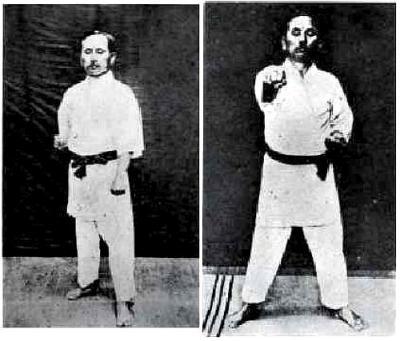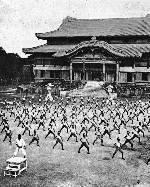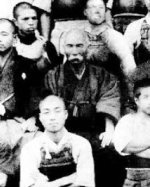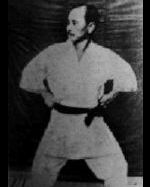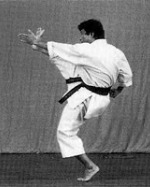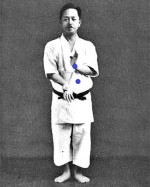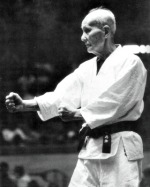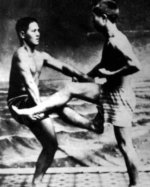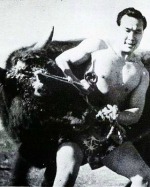Gichin Funakoshi – Father of Modern Day Karate
Talk the Talk
In 1935, a group of students and benefactors clubbed together and paid for the first purpose-built dojo in Japanese karate history.
Over the door was the name Shoto-kan; Shoto was what Gichin Funakoshi used as a pen name for his calligraphy and means Pine Waves and Kan means
building or house. Shotokan can therefore be said to mean the House of Pine Waves.
Walk the Walk
Gichin Funakoshi only fought a small number of times in his life, with one occasion being when he was in his late 80s and against a much younger would-be
mugger.
When attacked, the wise old master thrust his hand and gripped the assailant's groin area, then marched him off to the police station.
Despite the fact that the mugger instigated the situation, Sensei Funakoshi regretted resorting to violence afterwards.
Karate Quote
True karate is this: that in daily life one's mind and body be trained and developed in a spirit of humility, and that in critical times, one be devoted utterly to the cause of justice.
~ Gichin Funakoshi ~
~ Gichin Funakoshi ~
Gichin Funakoshi is commonly known as the father of modern-day karate and is probably the best-known name in karate history. He was born in the city of Shuri on the island of Okinawa in 1868 and by the age of eleven, was training with the great Okinawan teachers Anko Itosu and Yasutsune Azato.
At this time it was illegal to learn Okinawan martial arts, though that did not stop him and many others from practicing in secret. Around the turn of the century, the art came out into the open and began to be taught in public schools, thanks largely to the efforts of Anko Itosu.
Gichin Funakoshi and Japanese Karate History
By the time Funakoshi was an adult he excelled in karate, so much so that when the Crown Prince of Japan, Hirohito, visited Okinawa, Funakoshi was chosen to perform a demonstration for him. When the Japanese Ministry of Education held a demonstration of karate in Tokyo a year later in 1922, the Okinawan Department of Education who he worked for as a schoolteacher asked him to be the one to perform it and introduce the art to Japan; when he did, a new era in the history of the Japanese martial arts was born.
The people there were so impressed that he was asked to stay in the country to further demonstrate and teach his art, beginning with an invitation from Jigoro Kano, the founder of Judo, who asked Funakoshi to demonstrate karate in front of over one hundred of his students. After this, the requests kept coming so Sensei Funakoshi decided to move to Japan permanently. He quickly gained students in the universities in and around Tokyo and soon he had enough interest to start his own dojo.
The Development of Shotokan Karate
Gichin Funakoshi earned the title of the father of modern-day karate in a number of ways. One was that he adapted the training methods so that they could be more easily practised by everybody, regardless of age, ability or sex. He also made karate more accessible to the Japanese by changing the meaning of the word Kara.
Originally the meaning used was Chinese with Te meaning hand but the characters used for Kara could also mean empty in Japanese. As this fitted the style so well and because karate had developed to be very different from Chinese martial arts styles, it became the new meaning of the word. He also changed the name of many of the kata, again making them more acceptable to a Japanese culture that often hated everything that was Chinese.
Amongst his more prominent beliefs was his conviction that the best martial arts exponents should be so confident that they had nothing to prove about their fighting prowess. The true art was found in subduing an opponent without fighting, echoing the teachings of the legendary samurai Tsukahara Bokuden from over four hundred years previously.
In 1955, Sensei Gichin Funakoshi made another momentous contribution to Shotokan karate history when he was instrumental in founding the Japanese Karate Association (JKA). Funakoshi was the chief instructor but unfortunately, the great Master died not long after in 1957. However, through his most senior students such as Hidetaka Nishiyama and Masatoshi Nakayama, Shotokan karate lived on and grew. Today, it is practised by millions of students and is a famous fighting system, respected and feared throughout the world.
Written by Andrew Griffiths – Last updated 16/09/2023. If you like
what you see, consider following the History of Fighting on social media.
Further Reading:
Early Karate Origins. [Internet]. 2012. The University of Columbia. Available from: http://www.columbia.edu/cu/jka/history.html [Accessed 29 January, 2013].History of Shotokan Karate. [Internet]. 2012. Northwestern University. Available From: http://groups.northwestern.edu/karate/history.html [Accessed 29 January, 2013].
Karate-do: My Way of Life. [New Edition]. 1981. Gichin Funakoshi. Kodansha America, Inc. Tokyo.
Shotokan’s Secrets. [Internet]. 2004. Via Google Books. Available from: http://books.google.co.uk/books?id=BGxQeTMnPzQC&printsec=frontcover&dq=shotokan%27s+secret&hl=en&redir_esc=y [Accessed 13 November, 2012].
More Karate History
Karate History Home
The history of karate begins in Okinawa, where martial arts were influenced by both kung fu from China, and the Japanese samurai. After weapons were banned on the island, unarmed combat techniques were developed into a style of fighting recognisable as traditional karate, which was further developed after being taken to Japan in the early twentieth century by Gichin Funakoshi.
The history of karate begins in Okinawa, where martial arts were influenced by both kung fu from China, and the Japanese samurai. After weapons were banned on the island, unarmed combat techniques were developed into a style of fighting recognisable as traditional karate, which was further developed after being taken to Japan in the early twentieth century by Gichin Funakoshi.
The History of Okinawan Karate
A look at the history of Okinawan karate and how it developed from the seventeenth century. Okinawan martial arts had influences from both the Japanese samurai and Chinese kung fu, as well as techniques unique to the island itself which over the years blended and evolved into the traditional karate styles that are practiced all over the world today.
A look at the history of Okinawan karate and how it developed from the seventeenth century. Okinawan martial arts had influences from both the Japanese samurai and Chinese kung fu, as well as techniques unique to the island itself which over the years blended and evolved into the traditional karate styles that are practiced all over the world today.
The Life and Legends of Anko Itosu
Anko Itosu was a legendary Okinawan martial artist and a pioneer in the development of karate history. He popularised many aspects of the fighting system through his Shuri-te style and helped increase the number of people who were permitted to learn it by bringing karate training out of secrecy, and even gained permission to teach it in Okinawan schools.
Anko Itosu was a legendary Okinawan martial artist and a pioneer in the development of karate history. He popularised many aspects of the fighting system through his Shuri-te style and helped increase the number of people who were permitted to learn it by bringing karate training out of secrecy, and even gained permission to teach it in Okinawan schools.
The History of the Shotokan Kata – Part One
A look at the history of the more basic Shotokan kata, including their origins, development, interesting facts and scholastic debate. This list of kata histories includes, Kihon kata, the Heian kata, the Tekki group, Bassai Dai and Sho, Empi, Hangetsu, Kanku Sho and Dai, Jion, Ji’in and Jitte and includes video links to the relevant kata.
A look at the history of the more basic Shotokan kata, including their origins, development, interesting facts and scholastic debate. This list of kata histories includes, Kihon kata, the Heian kata, the Tekki group, Bassai Dai and Sho, Empi, Hangetsu, Kanku Sho and Dai, Jion, Ji’in and Jitte and includes video links to the relevant kata.
The History of the Shotokan Kata – Part Two
A look at the history of the more advanced Shotokan kata, including their origins, development, interesting facts and debated issues. This list of karate kata histories includes, Wankan, Gankaku, Meikyo, Chinte, Gojushiho Sho and Dai, Sochin, Nijushiho and Unsu, and includes video links to the relevant kata.
A look at the history of the more advanced Shotokan kata, including their origins, development, interesting facts and debated issues. This list of karate kata histories includes, Wankan, Gankaku, Meikyo, Chinte, Gojushiho Sho and Dai, Sochin, Nijushiho and Unsu, and includes video links to the relevant kata.
Kenwa Mabuni – Founder of Shito-Ryu Karate
Kenwa Mabuni started life as a sickly child but transformed himself into a strong warrior through the practice and dedication to the martial arts. Through his studies with
great karate masters such as Anko Itosu and Kanryo Higaonna, along with the kung fu master Woo Yin Gue, he was able to combine what he had learned and develop one of the four
major styles of traditional karate, Shito-Ryu.
Hironori Otsuka – Founder of Wado-Ryu Karate
Hironori Otsuka was a renowned master of jujitsu by the age of 28 before becoming a karate student under Gichin Funakoshi. He excelled and quickly rose through the ranks to become an assistant instructor, helping to develop training techniques in Shotokan karate. Later, Master Otsuka would brake away and form Wado-Ryu, one of the main four styles of traditional karate.
Hironori Otsuka was a renowned master of jujitsu by the age of 28 before becoming a karate student under Gichin Funakoshi. He excelled and quickly rose through the ranks to become an assistant instructor, helping to develop training techniques in Shotokan karate. Later, Master Otsuka would brake away and form Wado-Ryu, one of the main four styles of traditional karate.
The Real Mr Miyagi – Founder of Goju Ryu
Sensei Chojun Miyagi was an early karate master who studied martial arts in both China and his homeland, Okinawa. He earned his place in martial arts history when he used his knowledge to blend soft (or internal) with hard (or external) techniques to develop the style known as Goju-Ryu, which is considered one of the main four styles and is today widely practiced throughout the world techniques.
Sensei Chojun Miyagi was an early karate master who studied martial arts in both China and his homeland, Okinawa. He earned his place in martial arts history when he used his knowledge to blend soft (or internal) with hard (or external) techniques to develop the style known as Goju-Ryu, which is considered one of the main four styles and is today widely practiced throughout the world techniques.
Mas Oyama – Founder of Kyokushin Karate
Mas Oyama, founder of Kyokushin karate was one of the best karate masters of all time. He developed his body, mind and techniques through rigorous training and fought and won hundreds of full contact battles against fighters from many different martial arts styles. To test his skills further, he also went head to head with 52 bulls and was victorious in all, whether against man or beast.
Mas Oyama, founder of Kyokushin karate was one of the best karate masters of all time. He developed his body, mind and techniques through rigorous training and fought and won hundreds of full contact battles against fighters from many different martial arts styles. To test his skills further, he also went head to head with 52 bulls and was victorious in all, whether against man or beast.
The images on this site are believed to be in the public domain, however, if any mistakes have been made and your copyright or intellectual rights have been breeched, please contact andrew@articlesonhistory.com.

